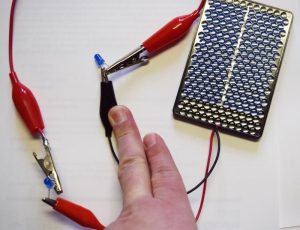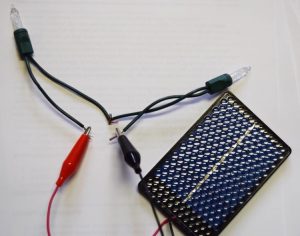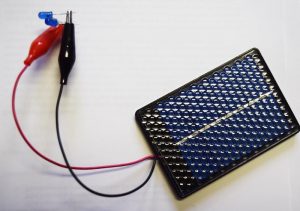Activity 3: Series and Parallel Circuits
Learning Targets:
- Construct a circuit using multiple solar panels as the power generators.
- Compare solar panel power output under different conditions.
- Understand how to use solar panels in the best way to capture solar energy.
- Recognize the potential for larger power – voltage and current – output that comes from the large solar panel arrays for scale power production.
Length: 40-50 minutes
Essential Questions:
- What is the difference between renewable and nonrenewable resources?
- What happens to power output when you add more panels?
- What happens to power output when the circuit is wired in series?
- What happens to power output when the circuit is wired in parallel?
- How much energy can we capture from the sun? What does this depend on? What solar panel system designs capture the most power?
Enduring Understandings:
- Understand how groups of solar panels can be used to create larger amounts of energy.
- Materials found in nature that are used by living things to meet their needs are called natural resources. Resources that can be replaced quickly are called renewable resources. Resources that take thousands or millions of years to be replaced are called non-renewable resources. We use both types of resources to generate power for our everyday needs. Humans require a lot of energy to get through the day and depend largely on utility companies to provide that energy. We have the technology to capture a lot of energy from renewable resources which would have positive impacts on the environment.
NGSS Standards:
- 4-PS3-2, 4-PS3-4
- 5-ESS3-1
- MS-PS3-3
Background for Facilitator:
This activity introduces the concepts of different types of circuits, series circuits, and parallel circuits. Facilitators might want to reference diagrams in the Elaborate section. A series circuit must have all items functioning for it to work. An example of this is a string of lights. If one light in the circuit does not work, then none of the lights will work. Another common example is a power strip with multiple plug-ins. Everything in the power strip is connected in a series circuit, with no way to make one outlet plug in work and others not work. A series circuit aims to have the same amount of current flow through all the components placed inline. It is called a ‘series’ because of the fact that the components are in the same single path of the current flow. For instance, when components such as resistors are put in a series circuit connection, the same current flows through these resistors, but each will have different voltages, assuming that the amount of resistance is dissimilar. The voltage of the whole circuit will be the sum of the voltages in every component or resistor.
A parallel circuit may have similar components, but each item has its own circuit. An example of this is a light fixture that has multiple light bulbs. One light bulb can go out, but the other lights will still work. Another example is electrical outlets in common house wiring. Each outlet can power a unique item that can be turned on/off independently of another item in the outlet. When in parallel, the components are wired in separate loops. This circuit splits the current flow, and the current flowing through each component will ultimately combine to form the current flowing in the source. The voltages across the ends of the components are the same; the polarities are also identical.
Parallel circuits are more complex than the simple circuits built earlier in this curriculum. As with any engineering problem, as more pieces of the puzzle are added, it is important to remind youth that this is a new challenge and is expected to be more complicated. As a group, we will need to work together as it is to be expected that the first design may not be successful. Maybe even the second or third – keep trying! If youth (or facilitators) get frustrated, reference some of the additional resources and videos at the end of this lesson. Refer to other members of the group, what have they tried that did or did not work.
Let’s draw out the same example given in the series circuit, and assume that the resistors are connected in parallel. The other term for ‘parallel’ circuits is ‘multiple’, because of the multiple connections. Additional resources that may be helpful are available on the Difference Between Series and Parallel Circuits page (DifferentBetween.net website).
The strength of sunlight, or light source, can impact the success of this activity. If not enough voltage is generated from one solar panel, consider adding a second panel to the circuit to harvest more energy and successfully light up the light bulb. It is important to be sure the positive and negative wires are correctly matched or the circuit will not flow. It is also important to pay careful attention to the circuits when assembled – it could be easy to damage products not connected correctly.
Safety tip: Youth should be told not to look directly at the sun or any area where the rays are concentrated. If youth are collecting their own materials (panels, light bulbs, fans, etc.), be sure to consider safety by not overloading systems or using materials that could put youth at risk.
Vocabulary List:
- Solar energy: Energy that comes directly from the sun
- Photovoltaic cell: A small part of a solar panel that creates energy from sunlight; many photovoltaic cells make up a solar panel.
- Series Circuit: A closed circuit in which the current follows one path.
- Parallel Circuit: A closed circuit where the current is divided into two or more paths.
- Polarity: the direction of electric or magnetic field
- Resistance: A material’s opposition to the flow of electric current; measured in ohms.
- Voltage: The force or “pressure” pushing the electricity through the circuit; measured in volts.
Materials:
- Solar panels
- Wires with alligator clips
- LED lights (colored lights are easier to see in bright sunlight)
- Series/Parallel Circuits Data Sheet (PDF) (to download and print)
Series/Parallel Circuit Data Sheet
| Variables | Voltage | Brightness |
|---|---|---|
| 1 Solar Panel | X | |
| 2 Solar Panels | X | |
| 1 Bulb | ||
| 2 Bulbs in Series | ||
| Remove 1 Bulb from the Circuit | ||
| 2 Bulbs in Parallel | ||
| Remove 1 Bulb from the Circuit |
- DC motor
- Small plastic fan
- Pencils
Goal: Help students visualize how to wire a circuit to maximum power output.
Methods:
Engage:
Begin by accessing the youth’s prior knowledge and discussing these key concepts:
- What does renewable mean? (something that can be replenished in a human lifetime)
- What kinds of energy are renewable? (solar, wind, geothermal, water)
- How can we use renewable energy sources? (power for houses, cars, run machines)
- What are some of the limitations to renewable energy? (winter sunlight reduction, money for solar panels or wind turbines, unreliable, expensive, etc.)
- Why does everyone not have a solar panel or wind turbine to power their home?
Explore:
Be sure to be in the sunlight (or a high-power spotlight) when testing.
- Let youth know that today we are going to explore different types of circuits that are built with renewable energy. The purpose of this is to help them understand how solar energy is collected and becomes usable energy for things we use in our everyday lives, such as fans.
- Youth should have access to materials, including a Series/Parallel Circuits Data Sheet (PDF) (to download and print or view the “Series/Parallel Circuit Data Sheet” table, above, under “Materials“).
- Have youth attach the DC motor to the plastic fan. Then they should connect one solar panel to the wires from the motor. Ask what they see happening as they are doing this. How could you increase the speed of the fan with the materials available?
- Allow youth to work together and test out their ideas. Have them make predictions about what changes they will see when they connect the fan to test. How will they know they are successful?
- Now that youth have tested out working with the solar panels and fans, have them connect one solar panel to the multimeter. Measure the voltage generated in the direct sun. What happens when they move into the shade? Remind them to make sure to write it down on their data sheet. Have groups predict how much it will go up if they add another group’s solar panel to their circuit.
- Have youth test out adding solar panels to their initial circuit. This should turn into groups working together, as they will need to work together to have access to materials. Remind them to write down the voltage on their data sheets.
Explain
Ask groups to discuss these questions. Encourage them to use the data they collected when making a claim to answer these questions.
- What happened to the energy captured with one solar panel? Use evidence to support your claim.
- How about when you added a second solar panel? Use evidence to support your claim?
- Why might this happen?
- How does changing how the solar panels are connected impact the amount of energy captured?
By linking the solar panels together this way, you created different types of circuits. Explain series circuits and parallel circuits using models created by the youth. Wiring in parallel produces the most power, because of reduced resistance.
Elaborate
Now let’s try a new way to use the energy. Instead of measuring the voltage/energy collected, we will test the energy capture with solar panels using light bulbs.
- Remove the multi-meter and add a light. Test the brightness. Tip: when using the smaller LED bulbs, typically the longer wire is the positive (red) and the shorter wire is the negative (black).
- Predict what will happen to the brightness of the light if you add another bulb directly to the first one (series).
-
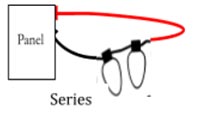
Figure 3.1: Series Circuit (Graphic, D.O. Neill) Try it out. How many bulbs can you light with a series circuit using one panel? How about two panels?
- Using the series circuit diagram, connect two bulbs to the circuit and describe the brightness.
- Predict what will happen to the brightness of the light if you add another bulb directly to the panel (parallel).
-
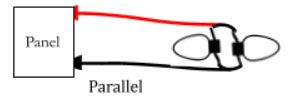
Figure 3.2: Parallel Circuit (Graphic, D.O. Neill) Using the parallel circuit diagram, connect two bulbs to the circuit and describe the brightness. How many bulbs can you light with a parallel circuit using one panel? How about two panels?
Series Circuits:
- Figure 3.3: Series Circuit (UMaine Extension 4-H Photo, Sarah Sparks)
- Figure 3.4: Series Circuit (UMaine Extension 4-H Photo, Sarah Sparks)
Parallel Circuits:
- Figure 3.5: Parallel Circuit (UMaine Extension 4-H Photo, Sarah Sparks)
- Figure 3.6: Parallel Circuit (UMaine Extension 4-H Photo, Sarah Sparks)
Evaluate
As a group, take time to reflect on the discoveries just made. Here are some questions to get you started:
- How did you feel when you were adding solar panels and light bulbs?
- What did you think was going to happen when you added a second solar panel? How about a second light bulb?
- How did you decide how to add a second solar panel or second light bulb?
- What did you observe?
Encourage youth to use observations and data collected with the Series/Parallel Circuits Data Sheet to support their claims by answering these questions:
- What happens when one of the light bulbs is removed from the series circuit?
- What happens when one of the light bulbs is removed from the parallel circuit?
- What effect did series circuits have on the light bulbs?
- What effect did parallel circuits have on the light bulbs?
- How might you use different types of circuits in the real world? Can you think of an example where you use these every day?
- In which setup did you get the most power output? Use evidence to support your claim.
- How do you think engineers decide whether to use series or parallel circuits in large solar arrays? Why do you think they design them that way?
- How could what you learned to be valuable in the future? How might this apply to the world around us?
Extension Ideas:
Try with 1.5V bulbs in holders or buzzers and measure speed or sound intensity.
How many solar panels would you need to meet your household energy needs? How could you figure this out?
Additional Resources:
- Electric Circuits – Lesson 4 – Circuit Connections, Two Types of Connections (the Physics Classroom website)
- Video: Series and Parallel Circuits (PBS Learning Media | Maine Public website)
- Renewable Solar, Solar Basics (energy KIDS | U.S. Energy Information Administration website)

